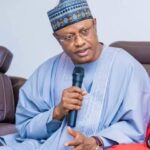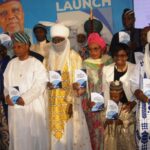The Out-of-School Children (OOSC) phenomenon in Nigeria has generated a lot of reports and counter reports especially on the figure. While the federal government has a figure below 10 million, the United Nations Educational, Scientific and Cultural Organisation (UNESCO) reports recently put it at 20 million, a figure that has raised concerns among stakeholders.
A report of UNESCO in 2022 said Nigeria now has about 20 million out-of-school children out of the about 200 million population. This is 20 per cent of the entire population and is more than the population of many countries including those in Africa.
The report said there are 244 million children and youth between the ages of six and 18 worldwide who are still out of school and “the region with the second highest out-of-school population is Central and Southern Asia with 85 million.” The top three countries with the most children and youth excluded from education are: India, Nigeria and Pakistan.
But the Federal Ministry of Education in an unpublished response tagged, “UNESCO Global Education Monitoring Report 2022 and the Phenomenon of Out-Of-School Children in Nigeria,” obtained by Daily Trust, said, “Though UIS has attempted to justify the methods used in arriving at the 20 million figure, the fact remains that this report is capable of misinforming the public, misrepresenting the actual situation of the out-of-school children in Nigeria and underrating the significant efforts made by the government in addressing the OOSC challenge.”
Vote candidates without discrimination, Catholic Bishops tell Nigerians
Buni slashes price of newly constructed modern markets
While noting that it’s the responsibility of states and local governments to provide primary and secondary education in Nigeria, the report said, the federal government has been working closely in partnership to develop the sub-sector generally and address the OOSC challenge.
“The federal government provides financial and technical assistance to the states and local governments as part of its intervention in the delivery of Universal Basic Education (UBE) which covers primary and junior secondary,” the report said.
The report explained that the 2018 Nigerian Publishers Association (NPA) study established the number of OOSC, age six – 11 (Primary School-going age), at 10.193,918, regionally distributed as follows: North Central: 1,329,111, North East: 2,0012,038, North West: 3,490,671, South East: 713,176, South South: 1,208,1832 and South West: 1,451,740.
Similarly, the figure of 6,192,081 was established for age 12– 14 for Junior Secondary School going age.
“The 2018 NPA took cognizance of Nigeria’s designated age bracket for universal basic education (primary and junior secondary, age six – 14) and did not extend to the senior secondary cadre (age 15 – 17) and the post-secondary school age of 18, which are both part of the UNESCO’s 20 million figure.”
The report however said, in the proper context, the 2018 NPA provides an authentic representation of the OOSC population in Nigeria, within the confines of basic education (primary and junior secondary school) as defined by the UBE Act 2004.
Causes of OOSC
According to Dr Aminu Abdu Bichi, in presentation on “Root Causes, Dimensions and Manifestations of the Out-of-School Children Phenomenon in Nigeria” the Economic, demand-side barriers that causes OOSC is poverty, children engaged in labour; residence location/rural-urban migration, and pursuit for material wealth by youths and limited employment opportunities for school leavers.
He said the socio cultural barriers that are hindering children’s access to continuous education include too young to attend school, early marriage, poor perception of western education, lower status accorded the Girl-child in the family and peer pressure.
Nigeria’s slow but steady efforts at cutting the out-of-school children rate
Imo state, along with 13 other Nigerian states and the Federal Capital Territory (FCT) witnessed a significant decline in the rate of OOSC to less than 10 per cent within four years, between 2018 and 2021.
This is coming at a time when there are global concerns of children of school age not being in school and exposed to child labour as well as other vices.
The report is according to analysis of data obtained from the Multiple Indicator Cluster Surveys (MICS) by the National Bureau of Statistics (NBS) and the National Personnel Audit (NPA) by the Universal Basic Education Commission (UBEC).
The data was for OOSC at Primary Level by State across the years.
14 states, FCT recorded significant drop
Leading the 15 states that hit a single digit decline in out of school children within four years is Imo as its rate dropped from 17.2% to 0.6% as of 2021. Ekiti dropped from 17% to 2.4%, Lagos which had 19.2% dropped to 2.5%, Bayelsa that had 24.9% of out of school children saw it decline to 2.9%, while Abia dropped its figure from 23.3% to 2.9% between 2018 and 2021.
Three states comprising Cross River, Ebonyi and Akwa Ibom had their out of school children rate dropped to a 3% range from over 20% within the four years while Rivers and Ondo states got 4.3% and 4.5% decline from 34% and 21.8% respectively.
Edo state dropped from 23.6% to 5.1%, Kogi dropped to 6.1% from 24.1%, Delta had its figure declined to 7.2% from 20.4%, and Oyo got 8.3% from 202.2%. FCT-Abuja, the nation’s capital, slightly fell into the single digit range with a 9.1% rate in 2021 from a 13.9% out of school children rate in 2018.
7 states’ efforts to tackle education challenge
Seven states were said to have some significant efforts in tackling the education deficiency among children. While they had over 20% negative growth trajectory in 2018, the states recorded some decline in the number of out of school children in 2021 dropping to below 20%.
Enugu state led this category as its high OOSC rate dropped from 20.3% to 10.1% followed by Ogun from 26% to 10.3%. Benue dropped from 28.7% to 12.8%; Osun’s figure declined from 26.6% to 13%, Plateau’s dropped from 33.7% to 17.8%, Kaduna dropped from 21.6% to 18% while Kwara’s figure which was at 20.1% dropped to 18.4%.
15 states grapple with high out of school children rate
The analysis further shows that Kebbi and 14 other states have contended with higher percentages of the number of children that are out of school between 2018 and 2021.
Kebbi, which had a 22.3% rate in 2018, shot to 64.8% of children that are not in school by 2021, an over 200% rise that placed the state negatively above all other states during the period.
Zamfara, ravaged by banditry and communal clashes is next among the 22 states with an alarming rate of OOSC at 61.4%, rising from 41.1%.
The third state with negative growth is Bauchi at 60.8% rising from 26.6% four years earlier. There are four states within the 50% range and they are Yobe, Gombe, Sokoto and Borno. These states all had less than 50% OOSC growth rate in 2018.
Jigawa and Niger states were within the 40% growth band recording 43.9% and 40.4%: Jigawa grew negatively from 25.8% while Niger rose from 24.2%. Three other states comprising Katsina, Kano and Adamawa rose from around 22% to between 30% and 33.5% just as three other states – Taraba, Nasarawa and Anambra had negative growths within the 20% growth band.
Efforts of government, partners
The federal government has always received the knock-on issues of OOSC, thus took the various efforts at tackling the menace such as reinforcing the implementation of the UBE programme in partnership with States towards ensuring that all children of school-going age acquire a minimum of basic education.
According to the federal ministry of Education efforts were stepped up in improving access for vulnerable groups in UBE delivery especially the Almajiri and learners in the Qur’anic schools, saying, this has provided access for over 2,292,439 learners in basic education predominantly in the Northern States.
Also the implementation of the Better Education Service Delivery for All (BESDA) with a view to reducing the number of OOSC using both formal and non-formal approaches in the 17 States with the highest number of OOSC in the country.
“The target of 3 million children set in 2019 to be brought into school through the BESDA programme has been surpassed. Between 2019 and 2022, there were a total of 5,076,830 learners in the non-formal centres made up of 1,600,123 in cohort 1 (2019/2020) and 3,476,707 in cohort 2 (2022), as verified and confirmed by the National Bureau of Statistics (NBS).”
Despite all efforts challenges persists
A document obtained from Universal Basic Education Commission (UBEC), tagged : “Addressing the Challenges of Out-of-school Children phenomenon in Nigeria: Efforts and Lessons Learned” said despite recent improvements and persistent efforts of the Federal Government, the challenge of OOSC still poses one of the most significant areas of concern affecting Nigeria’s educational development.
The paper said 1 in 5 of the world’s OOSC is in Nigeria – approximately 10.2 million children in Nigeria who are OOS at the primary level and another 8.1 million who are OOS at the junior secondary level, accounts for 15% of the total number of OOSC globally.
One in three children is OOS in Nigeria, with 12.4 million having never attended and 5.9 million having left school early.
66% of all OOSC are in the northeast and northwest, 86 percent are from rural areas, and 65% are from the poorest socio-economic quintile.
More than 50% of girls are not attending school at the basic education level, and only 1 in 3 adolescents eligible for senior secondary education are attending.
UBEC’s position
UBEC which is central to ensuring that children attend school in Nigeria, has said with Nigeria’s commitment to provide equal access to free, universal, and quality basic education to all children of primary and junior secondary school age, the number of students in primary education increased by 45%, and in JSS, student enrolment tripled between 2000 and 2018.
“GER in primary education improved from 85.1 in 2010 to 87.5 in 2018. School Net Attendance Rates improved from 64% in 2007 to 68% in 2021. The primary OOSC rate declined from 37 percent to 32 percent between 2018 and 2021,” the paper said.
Expert speaks
An Educationist, Michael Ojonugwa, said the issue of OOSC can be addressed if government pushes so hard to ensure that parents and local government authority faces penalty if they failed to send their wards to school, this of course is after government has made the necessary provisions in terms of infrastructure, good environment and learning materials.
“If children have a good learning environment, I believe many will not want to be on the street to hawk. And if a law that bans children from being at home or street during school hours are enacted and religiously implemented, I believe the OOSC menace will be history,” he said.
He also noted that having relevant data and evidence of what is being done will help in addressing the discrepancy in the figure being given out by different organisations.

 Join Daily Trust WhatsApp Community For Quick Access To News and Happenings Around You.
Join Daily Trust WhatsApp Community For Quick Access To News and Happenings Around You.


